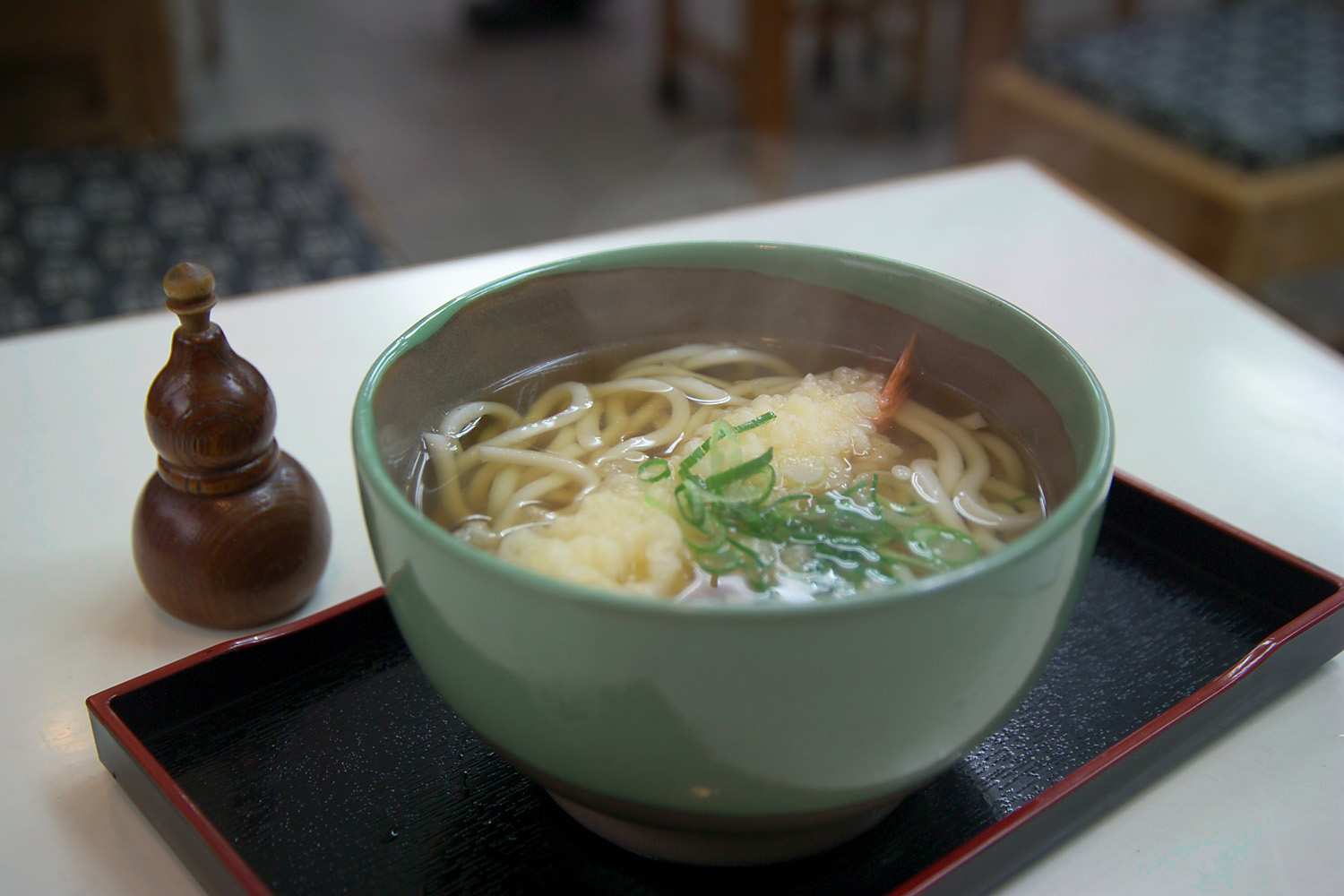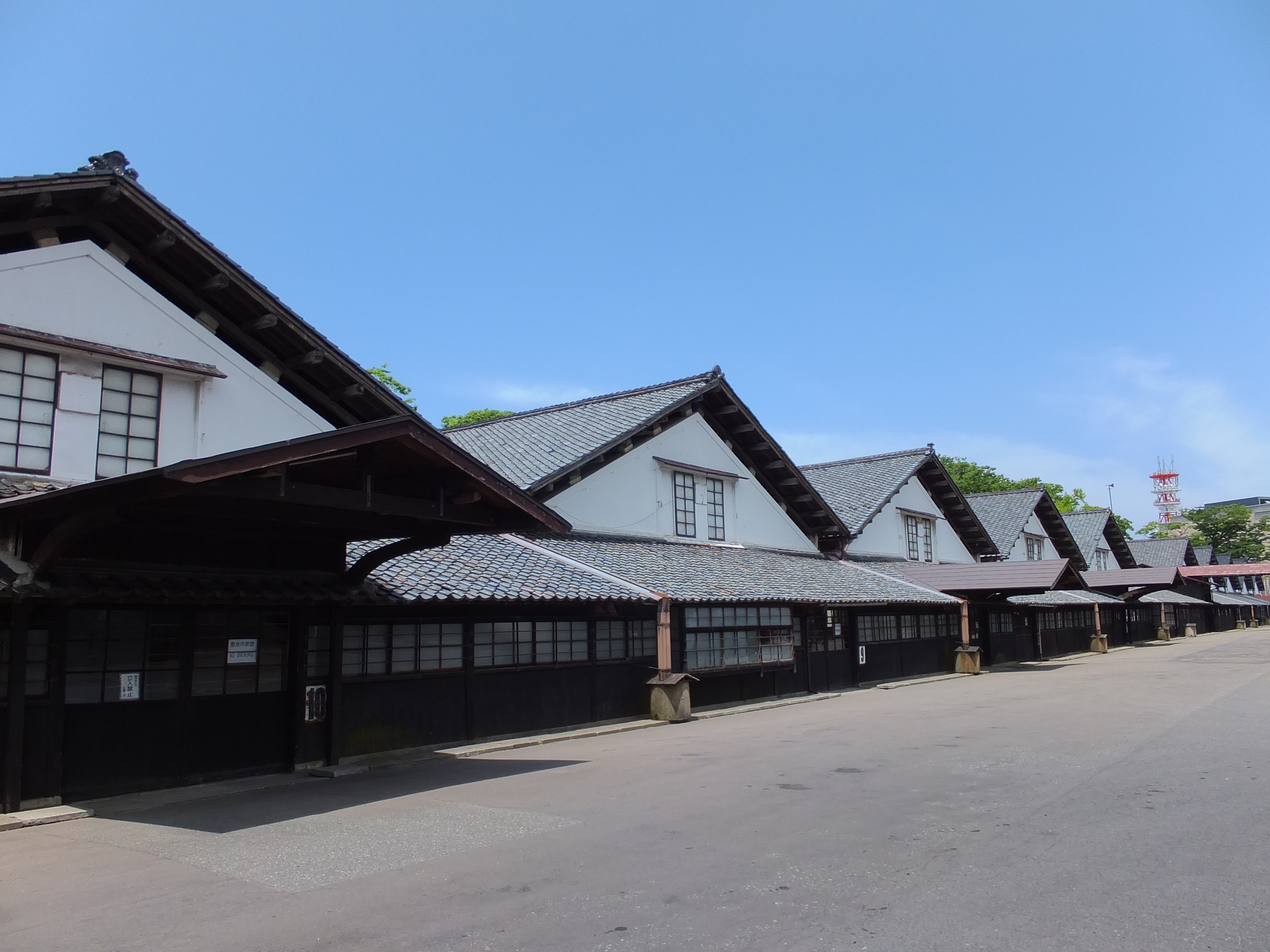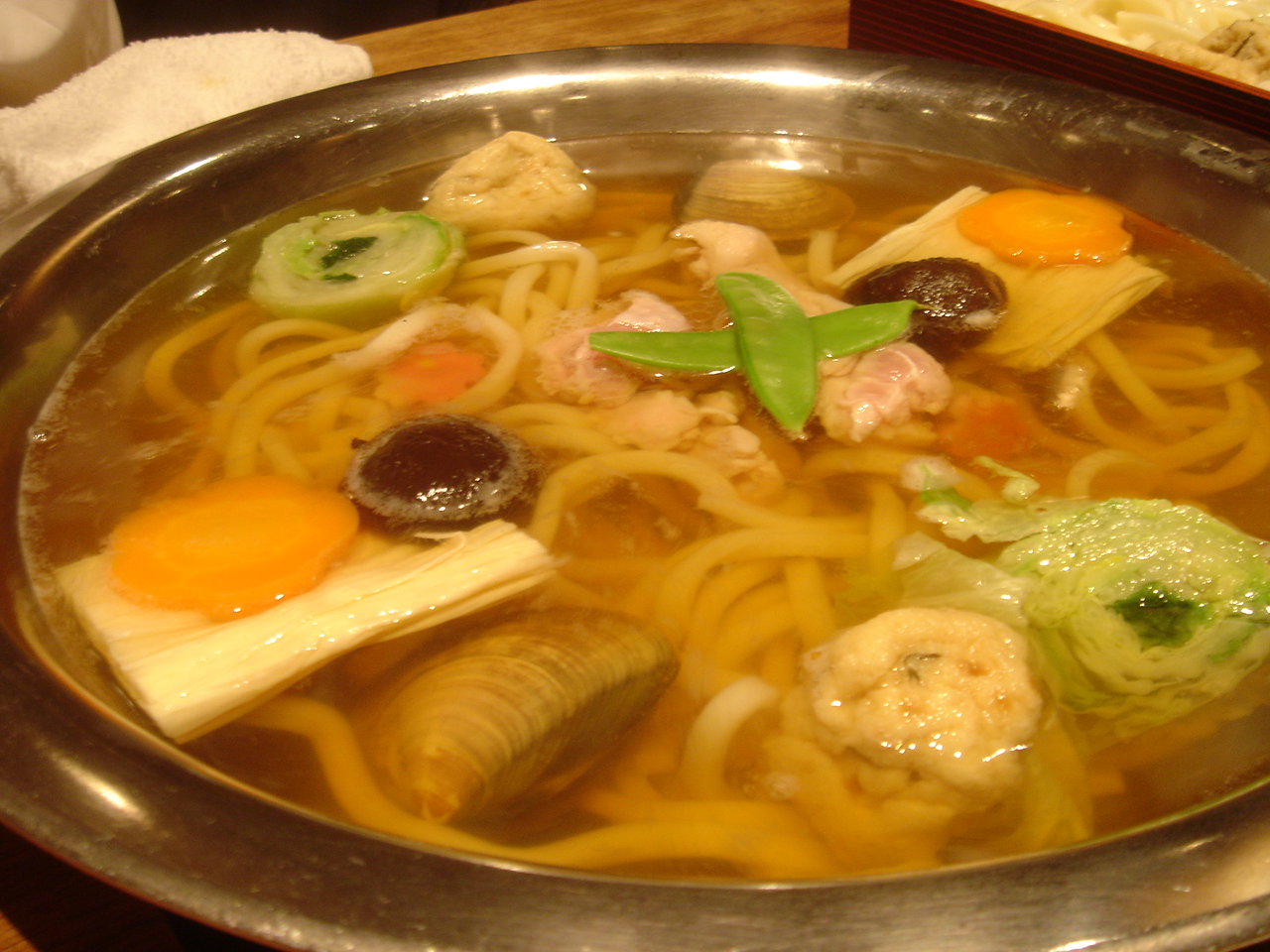|
Imoni
is a type of taro and meat soup eaten traditionally in the autumn in the Tōhoku region of Japan. Yamagata Prefecture in particular is famous for its imoni, but other prefectures in the region also have their own different varieties. Imoni is eaten like any soup, primarily during the late summer and early autumn, but is most famous as an outdoor food. In the autumn, groups of people preparing imoni around a fire near a river is considered a sign of the season, and convenience stores maintain a stock of firewood and other supplies just for the occasion. Ingredients The different recipes for imoni vary from prefecture to prefecture: for example, inland Yamagata imoni contains beef, sugar, and soy sauce and is sweet, while the imoni prepared in the neighbouring prefecture of Miyagi does not, but includes miso paste to flavour the soup. Similarly, even the Shōnai region of Yamagata features a pork and miso base rather than the beef and soy sauce base of inland areas of the same p ... [...More Info...] [...Related Items...] OR: [Wikipedia] [Google] [Baidu] |
List Of Japanese Dishes
Below is a list of dishes found in Japanese cuisine. Apart from rice, staples in Japanese cuisine include noodles, such as soba and udon. Japan has many simmered dishes such as fish products in broth called oden, or beef in sukiyaki and nikujaga. Foreign food, in particular Chinese food in the form of noodles in soup called ramen and fried dumplings, gyoza, and western food such as curry and hamburger steaks are commonly found in Japan. Historically, the Japanese shunned meat, but with the modernization of Japan in the 1860s, meat-based dishes such as tonkatsu became more common. Rice dishes () * ''Gohan'' or ''meshi'': plainly cooked white rice. It is such a staple that the terms ''gohan'' and ''meshi'' are also used to refer to meals in general, such as ''Asa gohan/meshi'' ( breakfast), ''Hiru gohan/meshi'' ( lunch), and ''Ban gohan/meshi'' ( dinner). Also, raw rice is called ''kome'' ( rice), while cooked rice is ''gohan'' ( ookedrice). Nori (), and furikake () are popula ... [...More Info...] [...Related Items...] OR: [Wikipedia] [Google] [Baidu] |
List Of Japanese Soups And Stews
This is a list of Japanese soups and stews. Japanese cuisine is the food—ingredients, preparation and way of eating—of Japan. The phrase refers to the makeup of a typical meal served, but has roots in classic ''kaiseki'', '' honzen'', and ' cuisine. The term is also used to describe the first course served in standard ''kaiseki'' cuisine nowadays., p.158, explains that in the tea kaiseki, the Japanese soups and stews Soup/'' Shirumono'' * ''Butajiru'' – Also known as ''tonjiru''. Soup made with pork and vegetables, flavoured with miso. * Dashi – a class of soup and cooking stock used in Japanese cuisine. * Sweet corn porridge soup. * '' Kasujiru'' * '' Kenchin jiru'' * Miso soup * '' Noppe'' * ''Ohaw'' * ''Suimono'' - generic name for clear traditional soups ** ''Ushiojiru'' – clear soup of clams * '' Torijiru'' – Chicken soup * '' Zenzai'' – In Okinawa Prefecture, refers to red bean soup served over shaved ice with ''mochi'' * ''Zōni'' Noodle soup * ' ... [...More Info...] [...Related Items...] OR: [Wikipedia] [Google] [Baidu] |
Yamagata Prefecture
is a prefecture of Japan located in the Tōhoku region of Honshu. Yamagata Prefecture has a population of 1,079,950 (1 June 2019) and has a geographic area of 9,325 km² (3,600 sq mi). Yamagata Prefecture borders Akita Prefecture to the north, Miyagi Prefecture to the east, Fukushima Prefecture to the south, and Niigata Prefecture to the southwest. Yamagata is the capital and largest city of Yamagata Prefecture, with other major cities including Tsuruoka, Sakata, and Yonezawa. Yamagata Prefecture is located on Japan's western Sea of Japan coast and its borders with neighboring prefectures are formed by various mountain ranges, with 17% of its total land area being designated as Natural Parks. Yamagata Prefecture formed the southern half of the historic Dewa Province with Akita Prefecture and is home to the Three Mountains of Dewa, which includes the Haguro Five-story Pagoda, a recognised National Treasure of Japan. History The aboriginal people once inhabited the area ... [...More Info...] [...Related Items...] OR: [Wikipedia] [Google] [Baidu] |
Japan
Japan ( ja, 日本, or , and formally , ''Nihonkoku'') is an island country in East Asia. It is situated in the northwest Pacific Ocean, and is bordered on the west by the Sea of Japan, while extending from the Sea of Okhotsk in the north toward the East China Sea, Philippine Sea, and Taiwan in the south. Japan is a part of the Ring of Fire, and spans Japanese archipelago, an archipelago of List of islands of Japan, 6852 islands covering ; the five main islands are Hokkaido, Honshu (the "mainland"), Shikoku, Kyushu, and Okinawa Island, Okinawa. Tokyo is the Capital of Japan, nation's capital and largest city, followed by Yokohama, Osaka, Nagoya, Sapporo, Fukuoka, Kobe, and Kyoto. Japan is the List of countries and dependencies by population, eleventh most populous country in the world, as well as one of the List of countries and dependencies by population density, most densely populated and Urbanization by country, urbanized. About three-fourths of Geography of Japan, the c ... [...More Info...] [...Related Items...] OR: [Wikipedia] [Google] [Baidu] |
Daikon
Daikon or mooli, ''Radish, Raphanus sativus'' Variety (botany), var. ''longipinnatus,'' is a mild-flavored winter radish usually characterized by fast-growing leaves and a long, white, root. Originally native to continental East Asia, daikon is harvested and consumed throughout the region, as well as in South Asia, and is available internationally. In some locations, daikon is planted for its ability to break up compacted soils and recover nutrients, but is not harvested. Names In culinary contexts, ''daikon'' ( ja, 大根, lit=big root) or are the most common names in all forms of English. British India, Historical ties to South Asia permit ''mooli'' () as a general synonym in English. The generic terms white radish, winter radish, Oriental radish, long white radish, and other terms are also used. Other synonyms usually vary by region or describe #Varieties, regional varieties of the vegetable. When it is necessary to distinguish the usual Japanese form from others, it is ... [...More Info...] [...Related Items...] OR: [Wikipedia] [Google] [Baidu] |
Japanese Regional Cuisine
Japanese cuisine has a vast array of regional specialities known as ''kyōdo ryōri'' (郷土料理) in Japanese, many of them originating from dishes prepared using local ingredients and traditional recipes. Accessed July 2011. While "local" ingredients are now available nationwide, and some originally regional dishes such as and Edo-style have spread throughout Japan and are no longer considered as such, many regional specialities s ... [...More Info...] [...Related Items...] OR: [Wikipedia] [Google] [Baidu] |
Nabemono
''Nabemono'' (鍋物, なべ物, ''nabe'' "cooking pot" + ''mono'' "thing"), or simply ''nabe'', is a variety of Japanese cuisine, Japanese steamboat (food), hot pot dishes, also known as one pot dishes and "things in a pot". Description Nabemono are stews and soups containing many types of ingredients that are served while still boiling. Because of that, Nabe is typically enjoyed in cold days or the winter. In modern Japan, nabemono are kept hot at the dining Furniture, table by portable stoves. The dish is frequently cooked at the table, and the diners can pick the cooked ingredients they want from the pot. It is either eaten with the broth or with a dip. Further ingredients can also be successively added to the pot. There are two types of nabemono in Japan: lightly flavored stock (mostly with kombu) types such as ''yudōfu'' (湯豆腐) and ''mizutaki'' (水炊き), eaten with a dipping sauce (''tare sauce, tare'') to enjoy the taste of the ingredients themselves; and stro ... [...More Info...] [...Related Items...] OR: [Wikipedia] [Google] [Baidu] |
Maitake
''Grifola frondosa'' (also known as hen-of-the-woods, in Japanese, ram's head or sheep's head) is a polypore mushroom that grows at the base of trees, particularly old growth oaks or maples. It is typically found in late summer to early autumn. It is native to China, Europe, and North America. Description Like the sulphur shelf mushroom, ''G. frondosa'' is a perennial fungus that often grows in the same place for several years in succession. It occurs most prolifically in the northeastern regions of the United States, but has been found as far west as Idaho. ''G. frondosa'' grows from an underground tuber-like structure known as a sclerotium, about the size of a potato. The fruiting body, occurring as large as , rarely , is a cluster consisting of multiple grayish-brown caps which are often curled or spoon-shaped, with wavy margins and broad. The undersurface of each cap bears about one to three pores per millimeter, with the tubes rarely deeper than . The milky-white sti ... [...More Info...] [...Related Items...] OR: [Wikipedia] [Google] [Baidu] |
Shiitake
The shiitake (alternate form shitake) (; ''Lentinula edodes'') is an edible mushroom native to East Asia, which is now cultivated and consumed around the globe. It is considered a medicinal mushroom in some forms of traditional medicine. Taxonomy and naming The fungus was first described scientifically as ''Agaricus edodes'' by Miles Joseph Berkeley in 1877. It was placed in the genus ''Lentinula'' by David Pegler in 1976. The fungus has acquired an extensive synonymy in its taxonomic history: *''Agaricus edodes'' Berk. (1878) *''Armillaria edodes'' (Berk.) Sacc. (1887) *''Mastoleucomychelloes edodes'' (Berk.) Kuntze (1891) *''Cortinellus edodes'' (Berk.) S.Ito & S.Imai (1938) *''Lentinus edodes'' (Berk.) Singer (1941) *''Collybia shiitake'' J.Schröt. (1886) *''Lepiota shiitake'' (J.Schröt.) Nobuj. Tanaka (1889) *''Cortinellus shiitake'' (J.Schröt.) Henn. (1899) *''Tricholoma shiitake'' (J.Schröt.) Lloyd (1918) *''Lentinus shiitake'' (J.Schröt.) Singer (1936) *''Lentinu ... [...More Info...] [...Related Items...] OR: [Wikipedia] [Google] [Baidu] |
Oyster Mushroom
''Pleurotus'' is a genus of gilled mushrooms which includes one of the most widely eaten mushrooms, '' P. ostreatus''. Species of ''Pleurotus'' may be called oyster, abalone, or tree mushrooms, and are some of the most commonly cultivated edible mushrooms in the world. ''Pleurotus'' fungi have also been used in mycoremediation of pollutants, such as petroleum and polycyclic aromatic hydrocarbons. Etymology The genus name ''Pleurotus'' literally means ''side ear'' in reference to the mushroom caps being laterally attached to the substrate. It is a composite of the Ancient Greek words : pleurá - ''side'', and the stem ''-oto'' referring to ears (from , ὠτός : ''ear''). Description The caps may be laterally attached (with no stipe). If there is a stipe, it is normally eccentric and the gills are decurrent along it. The term '' pleurotoid'' is used for any mushroom with this general shape. The spores are smooth and elongated (described as "cylindrical"). Where hyphae meet ... [...More Info...] [...Related Items...] OR: [Wikipedia] [Google] [Baidu] |
Shimeji
''Shimeji'' (Japanese: , or ) is a group of edible mushrooms native to East Asia, but also found in northern Europe. ''Hon-shimeji ( Lyophyllum shimeji'') is a mycorrhizal fungus and difficult to cultivate. Other species are saprotrophs, and ''buna-shimeji'' ('' Hypsizygus tesselatus'') is now widely cultivated. ''Shimeji'' is rich in umami-tasting compounds such as guanylic acid, glutamic acid, and aspartic acid. Species Several species are sold as ''shimeji'' mushrooms. All are saprotrophic except ''Lyophyllum shimeji''. ;Mycorrhizal * ''Hon-shimeji'' (), '' Lyophyllum shimeji'' :The cultivation methods have been patented by several groups, such as Takara Bio and Yamasa, and the cultivated ''hon-shimeji'' is available from several manufacturers in Japan. ;Saprotrophic * ''Buna-shimeji'' (, lit. beech shimeji), ''Hypsizygus tessellatus'', also known in English as the brown beech or brown clamshell mushroom :''Hypsizygus marmoreus'' is a synonym of ''Hypsizygus tessellatus' ... [...More Info...] [...Related Items...] OR: [Wikipedia] [Google] [Baidu] |
Mushrooms
A mushroom or toadstool is the fleshy, spore-bearing Sporocarp (fungi), fruiting body of a fungus, typically produced above ground, on soil, or on its food source. ''Toadstool'' generally denotes one poisonous to humans. The standard for the name "mushroom" is the cultivated white button mushroom, ''Agaricus bisporus''; hence the word "mushroom" is most often applied to those fungi (Basidiomycota, Agaricomycetes) that have a stem (Stipe (mycology), stipe), a cap (Pileus (mycology), pileus), and gills (lamellae, sing. lamella (mycology), lamella) on the underside of the cap. "Mushroom" also describes a variety of other gilled fungi, with or without stems, therefore the term is used to describe the fleshy fruiting bodies of some Ascomycota. These gills produce microscopic Spore#Fungi, spores that help the fungus spread across the ground or its occupant surface. Forms deviating from the standard morphology (biology), morphology usually have more specific names, such as "bolete", "p ... [...More Info...] [...Related Items...] OR: [Wikipedia] [Google] [Baidu] |







